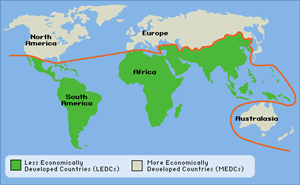- The First World
- The Second World
- The Third World
The First World
The First world mainly comprises of MEDCs, where a capitalist stream prevails, they tend to be described as free market economies, in the majority of the countries there is a varying degree of government intervention.
Countries include: UK, USA, France and Germany
The Second World
The Second world consist of socialist and communist countries where the governmental economic control is paramount. They are a mix of MEDCs and LEDCs. During the break up of the Soviet Union in the early 1990s and the communist bloc of Eastern Europe states in 1985-1995 started the process of economic restructuring of these countries.
The fall of communism allowed these former communist countries to move towards the First World. This has lead to the decline of the Second world.
Countries include: China, North Korea, Vietnam and Cuba
The Third World
The Third world consist of mainly of poor and underdeveloped countries (LEDCs and LLEDCs), these countries are mainly located in Asia, Africa and South America. Many of these countries in the Third world have recently gained political independance from colonial powers and they are now being drawn and welcomed into the global economy.
With these three divisions of the world in mind, the world is also split into the 'North South Divide'. This line separates the rich north (MEDCs) from the poor south (LEDCs). This is shown in the diagram below:

The only exception to this rule is Australasia. Below is a table showing some of the differences between the countries north and south of the line:
North
|
South
|
Developed countries
|
Developing countries
|
25% of the world’s population
|
75% of world population
|
Use 80% of the world’s resources, e.g. food and fuel
|
Use 20% of the world resources
|
80% of world income
|
20% of world income – most get less than £1.25 a week
|
Life expectancy – 70 years
|
Life expectancy – less than 50 years
|
12 children out of 1000 die before age 5
|
100+ out of 1,000 die before age 5
|
94% of the world’s healthcare
|
6% of the world’s health care
|
470 people per doctor, 140 people per nurse
|
14,000 people per doctor, 3,000 people per nurse
|
Easy access to medical care
|
70% never encounter medical care
|
Water - 100% access to clean water. No droughts.
|
Water - 70% get disease ridden, dirty water. 1 in 7 have serious droughts and water shortages
|
Food - virtually no hunger
|
Food - 1 billion people (20% world population) – not enough food
|
Malnutrition kills virtually nobody
|
Malnutrition causes 4 million childhood deaths per year; 40,000 people die every day of starvation, malnutrition, hunger and disease – most of which is preventable
|
90% of children get secondary education
|
10% of children get secondary education
|
No comments:
Post a Comment